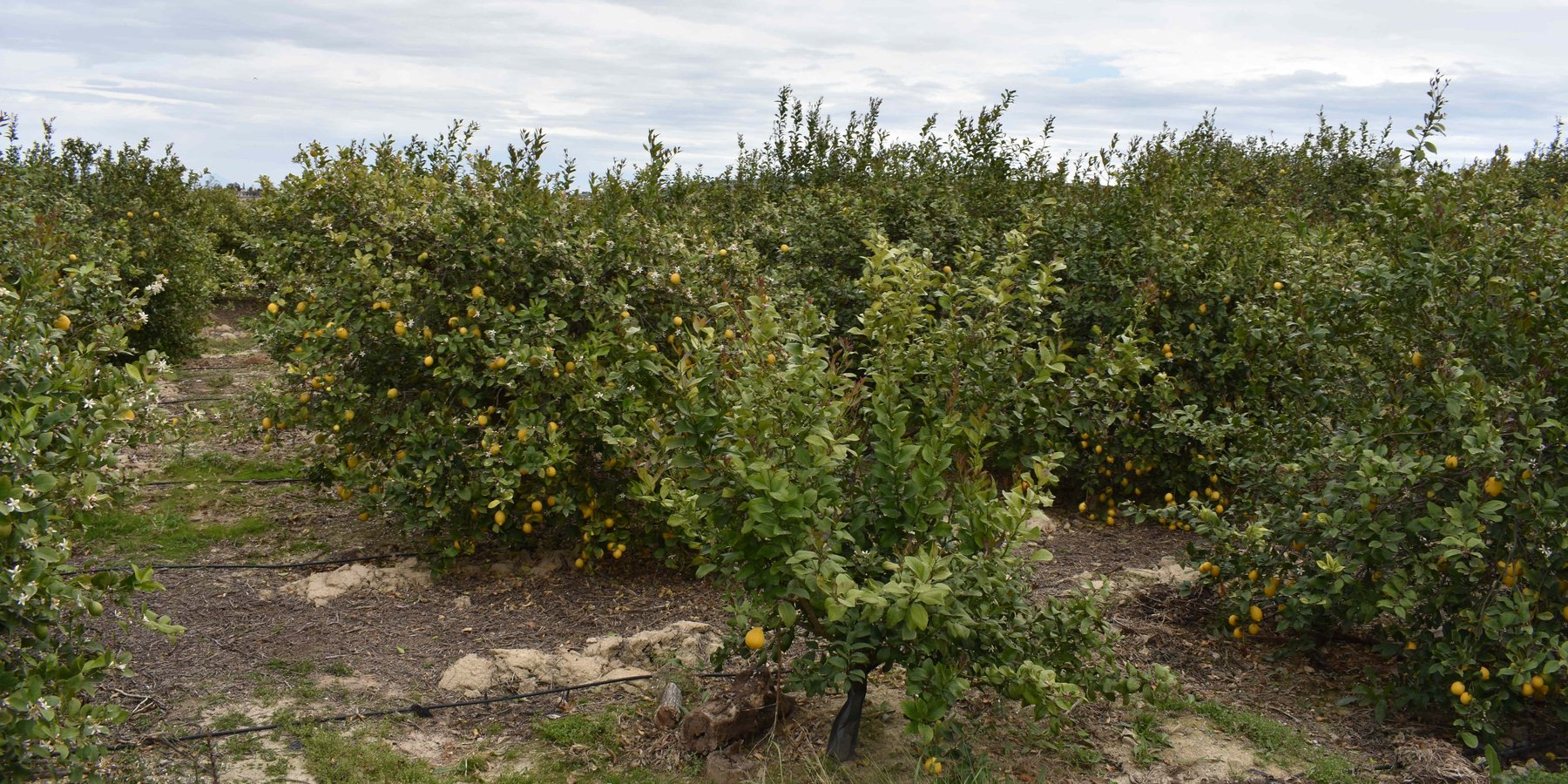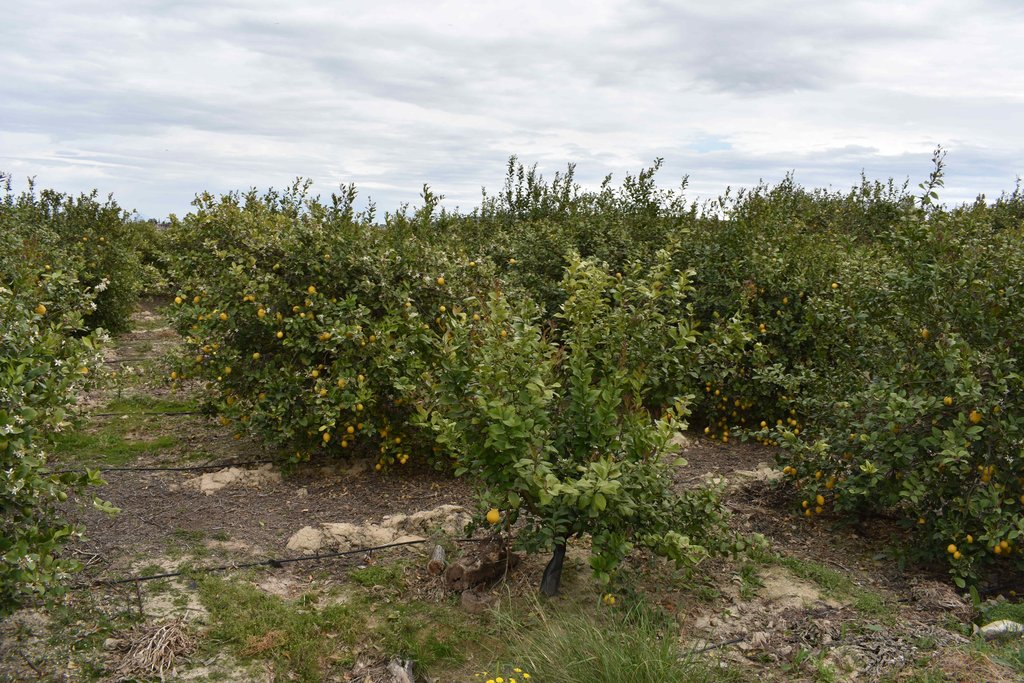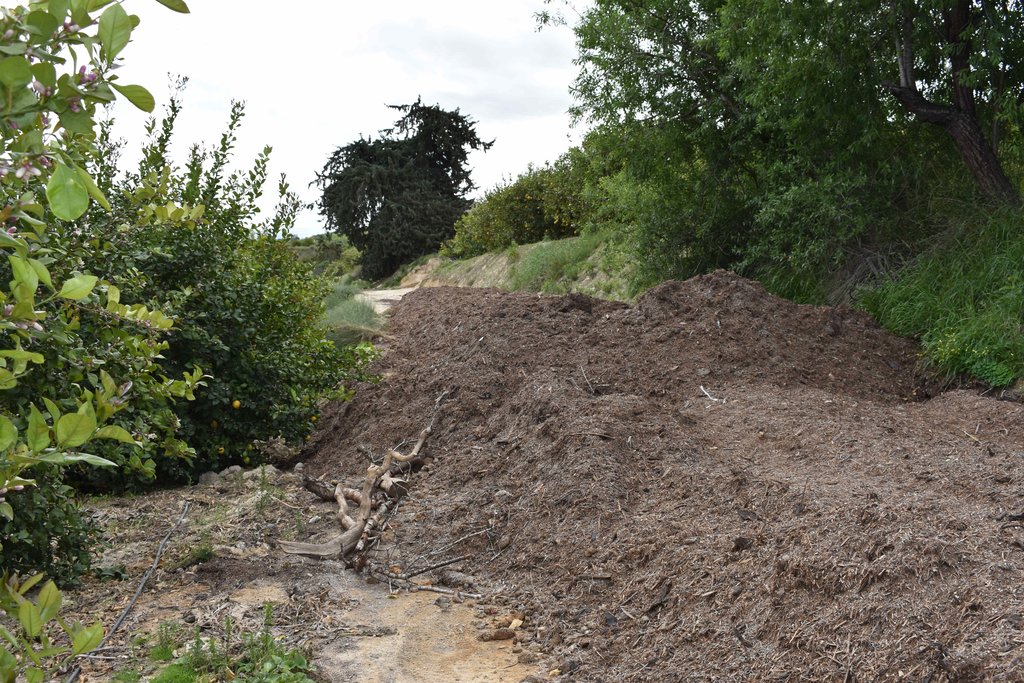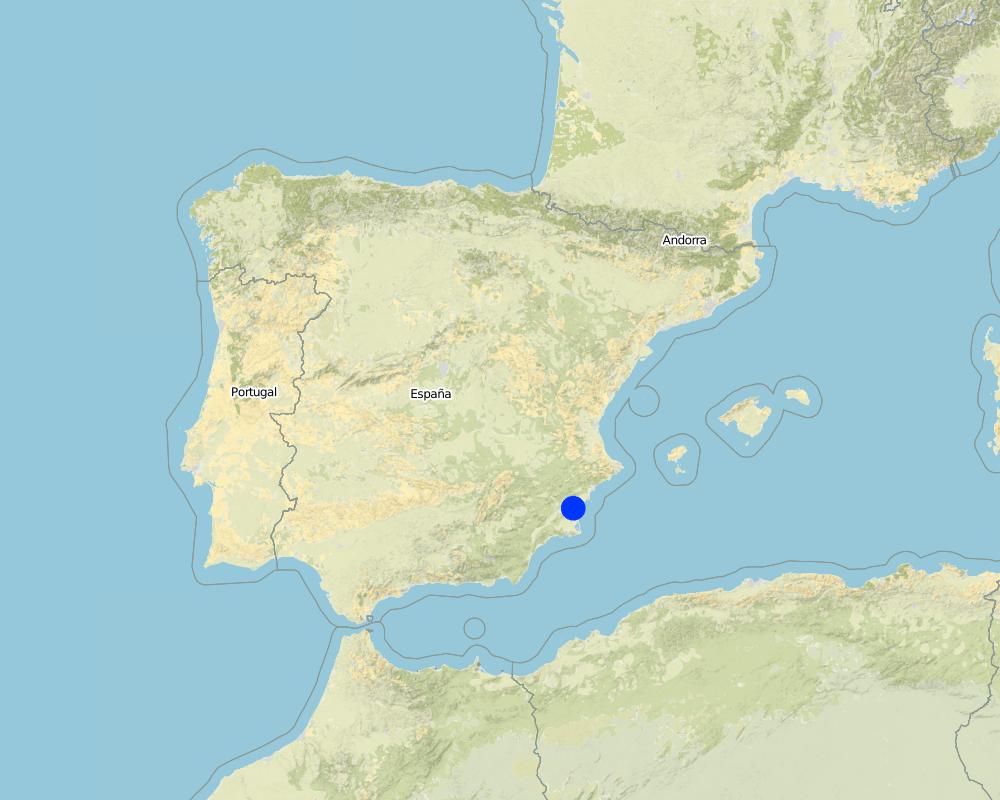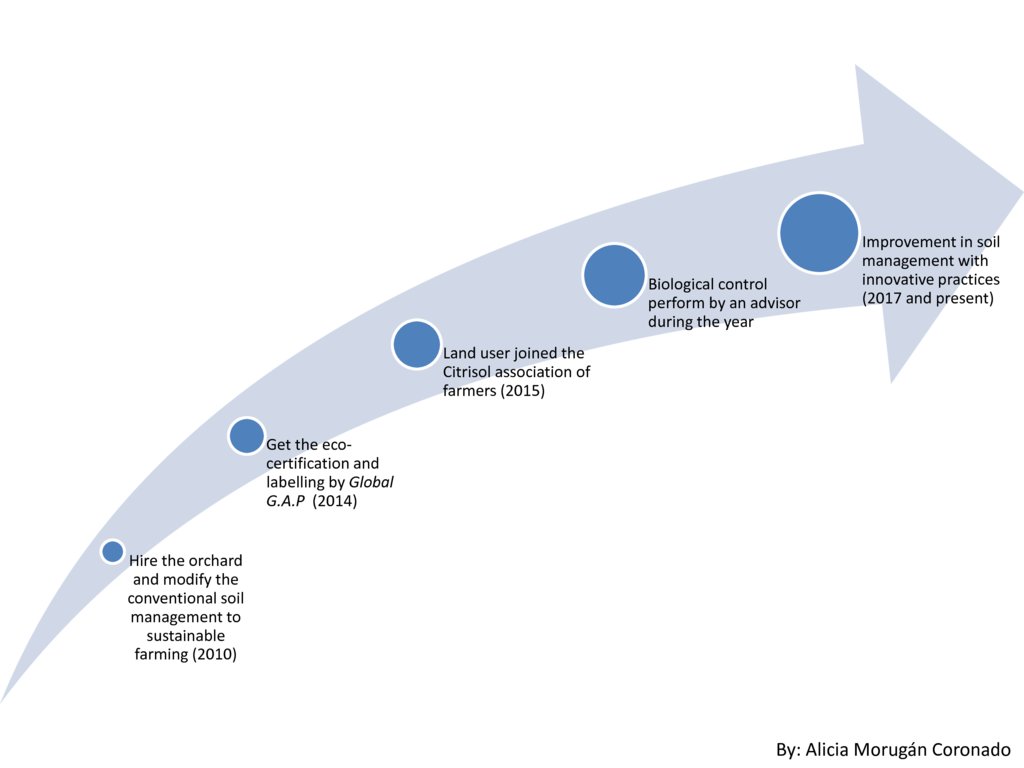Promoting Sustainable Agriculture in Citrus Orchards [Spain]
- Creation:
- Update:
- Compiler: Alicia Morugán-Coronado
- Editor: –
- Reviewers: Ursula Gaemperli, Gudrun Schwilch, Alexandra Gavilano
Ayuda al fomento de la agricultura ecológica en cultivos de cítricos
approaches_2058 - Spain
View sections
Expand all Collapse all1. General information
1.2 Contact details of resource persons and institutions involved in the assessment and documentation of the Approach
Key resource person(s)
land user:
ANDREU MARCOS JOSE VICENTE
649087588
jvagronomo@gmail.com
CITRISOL S.COOP.
Vereda Rincón de Gallego 10, 30579 Torreagüera (Murcia)
Spain
Name of project which facilitated the documentation/ evaluation of the Approach (if relevant)
Interactive Soil Quality assessment in Europe and China for Agricultural productivity and Environmental Resilience (EU-iSQAPER)Name of the institution(s) which facilitated the documentation/ evaluation of the Approach (if relevant)
Agrochesmistry and Environment Department, University Miguel Hernandez (UMH) - Spain1.3 Conditions regarding the use of data documented through WOCAT
When were the data compiled (in the field)?
23/03/2017
The compiler and key resource person(s) accept the conditions regarding the use of data documented through WOCAT:
Ja
2. Description of the SLM Approach
2.1 Short description of the Approach
Generally, this approach aims to encourage sustainable agricultural management in citrus orchards and keep environmental sustainability in the region of Vega Baja, in Alicante province (Spain). This approach is focused on enhancing production in the region and mantaining sustainable soil agricultural management soil to improve product quality.
2.2 Detailed description of the Approach
Detailed description of the Approach:
Water shortage and soil degradation are the two most important environmental problems in the Mediterranean area. Indeed, the problem will increase in the coming decades as a consequence of climate change as a result of a great decrease of precipitation and rising temperatures and increased evapotranspiration.
Thus, it is necessary to resort to strategies aimed at soil and water. Soil degradation is one of the main environmental problems caused, in many cases, by inadequate agricultural management of irrigation with low-quality water. Intensive arable agriculture and semiarid conditions cause a progressive decline in soil organic matter levels and associated soil fertility. In addition, under semi-arid conditions, Mediterranean soils are prone to loss of organic matter; increasing in semi-arid climates result in faster oxidation of organic matter and due the scarcity of rainfall causes vegetation cover to become very sparse. All of this leads to reduced input of organic matter into the soil. Thus, sustainable farming is necessary, e.g. organic fertilization systems have been amply implemented to increase plant productivity, reduce chemical inputs, and increase the sustainability of such agroecosystems. It is thus important to begin using organic inputs, such as manure as a nutrient source for crop production because it is imporant to improve soil organic matter. This would potentially lead to improving soil biology, fertility and physical fertility traits such as soil aggregation, porosity and water retention.
Generally, this approach aims to encourage sustainable agricultural management in citrus orchards and keep environmental sustainability in the region of Vega Baja, in Alicante province (Spain). Its specific objectives are:
(1) to enhance the agricultural production in the region,
(2) to maintain sustainable agricultural management in soil
(3) to improve product quality,
(4) to obtain organic food consumer demand in the country, and
(5) to develop a strong linkage and partnership among local stakeholders and cooperators to protect the resources.
Stages of implementation:
(1) Renting a conventional orchard and changing the agricultural management to include more sustainable practices
(2) Obtaining eco-labelling to sell organic food product in European markets
(3) Constant improvement and maintanence practices to improve soil fertility and productivity
(4) Monitoring and evaluation including operation and maintenance.
Role of stakeholders:
Land user:
1. Teaching other land users.
2. improving the knowledge through consulting IVIA.
3. Seeking advice from a biologist in identifying pests and diseases.
IVIA (Instituto Valenciano de Investigaciones Agrarias)
1. Disseminate results through small formation events.
2. Prepare farmer-led programs to implement soil and water conservation;
3. Provide technical support and assistance in the promotion and dissemination.
2.3 Photos of the Approach
2.4 Videos of the Approach
Comments, short description:
The video shows organic amendment application around all dripper point. The organic additives consist of sheep manure, which is applied in dripper point holes near to the lemon trees. The technology is part of the sustainable agricultural soil management of farming cooperative in the Vega Baja del Segura region, Southern Spain
Date:
23/03/2017
Location:
Municipality of Orihuela, Vega Baja del Segura region, Spain
Name of videographer:
Alicia Morugán Coronado
2.5 Country/ region/ locations where the Approach has been applied
Country:
Spain
Region/ State/ Province:
Vega Baja del Segura region, Spain
Further specification of location:
Orihuela
Comments:
Municipality of Orihuela, Vega Baja del Segura region, Spain
Map
×2.6 Dates of initiation and termination of the Approach
Indicate year of initiation:
2014
2.7 Type of Approach
- recent local initiative/ innovative
2.8 Main aims/ objectives of the Approach
The main objective is to obtain more sustainable healthy products with improvements in nutritive quality without chemical substances. The production is certified by Global G.A.P http://www.globalgap.org/es/index.html
2.9 Conditions enabling or hindering implementation of the Technology/ Technologies applied under the Approach
social/ cultural/ religious norms and values
- enabling
The promotion of sustainalble agriculture was enhance for the SLM technology implementation
availability/ access to financial resources and services
- hindering
No funding
institutional setting
- enabling
Several meetings with regional associations to explain the establishment of the SLM technology
collaboration/ coordination of actors
- enabling
Promote the collaboration with different stakeholders like students, researchers and farmers
knowledge about SLM, access to technical support
- enabling
Biological control advisor
markets (to purchase inputs, sell products) and prices
- enabling
Facilitates the presence in serveral markets
workload, availability of manpower
- enabling
The workload decrease with the implementation of SLM technology
3. Participation and roles of stakeholders involved
3.1 Stakeholders involved in the Approach and their roles
- local land users/ local communities
Farmers association
Promotion of product in markets
- SLM specialists/ agricultural advisers
Advisor
Biological control during the year
- researchers
Miguel Hernández University (UMH)
Assessing of soil properties
- international organization
Global G.A.P
Certification of Good Agricultural Practice (G.A.P.) label to the executing farm
3.2 Involvement of local land users/ local communities in the different phases of the Approach
| Involvement of local land users/ local communities | Specify who was involved and describe activities | |
|---|---|---|
| initiation/ motivation | none | Support on the idea of the implementation of sustainable management |
| planning | none | The land user planned the establishment of agricultural management by itself. |
| implementation | none | |
| monitoring/ evaluation | none |
3.3 Flow chart (if available)
Description:
In 2010 the land user hired a conventional orchard and modified the agricultural management to more sustainable practices, in 2014 certified by eco-labelling to sale organic food product in eurpoean markets, in present, the land user is in constant improvement and maintanence practices to improve soil fertility and productivity and monitoring and evaluation including operation and maintenance.
Author:
Alicia Morugán Coronado
3.4 Decision-making on the selection of SLM Technology/ Technologies
Specify who decided on the selection of the Technology/ Technologies to be implemented:
- land users alone (self-initiative)
Specify on what basis decisions were made:
- evaluation of well-documented SLM knowledge (evidence-based decision-making)
4. Technical support, capacity building, and knowledge management
4.1 Capacity building/ training
Was training provided to land users/ other stakeholders?
Nee
4.2 Advisory service
Do land users have access to an advisory service?
Ja
Specify whether advisory service is provided:
- on land users' fields
Describe/ comments:
Auditors from Global G.A.P as certifying institution
4.3 Institution strengthening (organizational development)
Have institutions been established or strengthened through the Approach?
- yes, greatly
Specify the level(s) at which institutions have been strengthened or established:
- regional
Describe institution, roles and responsibilities, members, etc.
Role of stakeholders: IVIA (Instituto Valenciano de Investigaciones Agrarias)
1. Disseminate results with small formation events. Prepare programs for the implementation of soil and water conservation through the farmers;
2. Provide technical support and assistance in the promotion and dissemination.
Specify type of support:
- capacity building/ training
Give further details:
Role of stakeholders: IVIA (Instituto Valenciano de Investigaciones Agrarias)
1. Disseminate results with small formation events. Prepare programs for the implementation of soil and water conservation through the farmers;
2. Provide technical support and assistance in the promotion and dissemination.
4.4 Monitoring and evaluation
Is monitoring and evaluation part of the Approach?
Ja
Comments:
Periodical biological control were performed in order to avoid plagues, IVIA controlled the progress of number of farmers adopting this technology.
If yes, is this documentation intended to be used for monitoring and evaluation?
Ja
Comments:
An advisor collect yearly the data of insects in the plot.
4.5 Research
Was research part of the Approach?
Ja
Specify topics:
- sociology
- ecology
- technology
Give further details and indicate who did the research:
Miguel Hernández University is taking soil sampling in order to know the soil quality of this sustainable agricultural area.
5. Financing and external material support
5.1 Annual budget for the SLM component of the Approach
If precise annual budget is not known, indicate range:
- 10,000-100,000
5.2 Financial/ material support provided to land users
Did land users receive financial/ material support for implementing the Technology/ Technologies?
Nee
5.3 Subsidies for specific inputs (including labour)
- none
If labour by land users was a substantial input, was it:
- paid in cash
5.4 Credit
Was credit provided under the Approach for SLM activities?
Nee
5.5 Other incentives or instruments
Were other incentives or instruments used to promote implementation of SLM Technologies?
Nee
6. Impact analysis and concluding statements
6.1 Impacts of the Approach
Did the Approach empower local land users, improve stakeholder participation?
- No
- Yes, little
- Yes, moderately
- Yes, greatly
Disseminate results with small formation events by land user as a teacher.
Did the Approach enable evidence-based decision-making?
- No
- Yes, little
- Yes, moderately
- Yes, greatly
Thanks to the approach the constant enhancement in the sustainable management is doing.
Did the Approach help land users to implement and maintain SLM Technologies?
- No
- Yes, little
- Yes, moderately
- Yes, greatly
The approach facilitates the implementation and maintenance of SLM technology in order to increase the product quality.
Did the Approach improve coordination and cost-effective implementation of SLM?
- No
- Yes, little
- Yes, moderately
- Yes, greatly
In short-term more costs than benefits.
Did the Approach mobilize/ improve access to financial resources for SLM implementation?
- No
- Yes, little
- Yes, moderately
- Yes, greatly
No, the land user didn't recieve funding during the process.
Did the Approach improve knowledge and capacities of land users to implement SLM?
- No
- Yes, little
- Yes, moderately
- Yes, greatly
yes, the constant improvement and modifications in the sustainable management involve the land user in the increase of agricultural knowledge.
Did the Approach improve knowledge and capacities of other stakeholders?
- No
- Yes, little
- Yes, moderately
- Yes, greatly
Yes, the land user gives some small training coursers to other farmers.
Did the Approach build/ strengthen institutions, collaboration between stakeholders?
- No
- Yes, little
- Yes, moderately
- Yes, greatly
Yes, in 2015 the land user joined to the Citrisol farmer association.
Did the Approach encourage young people/ the next generation of land users to engage in SLM?
- No
- Yes, little
- Yes, moderately
- Yes, greatly
The training course is targeting to young local farmers.
Did the Approach lead to improved food security/ improved nutrition?
- No
- Yes, little
- Yes, moderately
- Yes, greatly
Yes, the approach is focused in improve the product quality following a sustainable soil management.
Did the Approach improve access to markets?
- No
- Yes, little
- Yes, moderately
- Yes, greatly
Yes, all the product is sold in regional, national and european markets
Did the Approach lead to employment, income opportunities?
- No
- Yes, little
- Yes, moderately
- Yes, greatly
The approach lead to market opportunities
6.2 Main motivation of land users to implement SLM
- increased production
The production increase after changing the agricultural management to sustainable practices.
- reduced land degradation
The maintenance of permanent soil cover and the manure inputs, reduce the land degradation.
- environmental consciousness
The most important motivation of land user is the environmental consciousness
- enhanced SLM knowledge and skills
The land user is constantly learning and improving his skills in sustainable soil management and biological pest control.
6.3 Sustainability of Approach activities
Can the land users sustain what has been implemented through the Approach (without external support)?
- yes
If yes, describe how:
The land user can sustain the costs because the lemon price on the market increases thanks to the sustainable certification.
6.4 Strengths/ advantages of the Approach
| Strengths/ advantages/ opportunities in the land user’s view |
|---|
| Improvement in soil productivity and fertility |
| Improvement in soil biodiversity |
| Soil degradation reduction |
| Strengths/ advantages/ opportunities in the compiler’s or other key resource person’s view |
|---|
| Greater social recognition |
| Avoiding herbicides and pesticides is beneficial for labour health |
| Sustainable farming improves the plant function and responser against plagues. |
6.5 Weaknesses/ disadvantages of the Approach and ways of overcoming them
| Weaknesses/ disadvantages/ risks in the land user’s view | How can they be overcome? |
|---|---|
| Modification in the quantity of manure during the year. | According to the product and soil requirements |
| Exhaustive control in plagues and pest | Hire an external advisor |
| Weaknesses/ disadvantages/ risks in the compiler’s or other key resource person’s view | How can they be overcome? |
|---|---|
| The implementation process requires an excessive investment of money | Funding is required in this step |
| Important reliance on weather conditions | Recieve monetary compensation in case of product losses |
7. References and links
7.1 Methods/ sources of information
- field visits, field surveys
1
- interviews with land users
2
- interviews with SLM specialists/ experts
1, biological control advisor
7.2 References to available publications
Title, author, year, ISBN:
no
7.3 Links to relevant information which is available online
Title/ description:
Citrisol S.Coop (farmers association)
URL:
http://citrisol.es/
Title/ description:
Local Newspaper
URL:
http://valenciafruits.com/alicante-campana-de-limon/
Title/ description:
Local newspaper
URL:
http://www.agroinformacion.com/balance-aceptable-la-campana-citricos-alicante-gracias-al-incremento-produccion-precios-estables/
Links and modules
Expand all Collapse allLinks
No links
Modules
No modules


